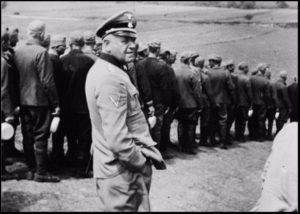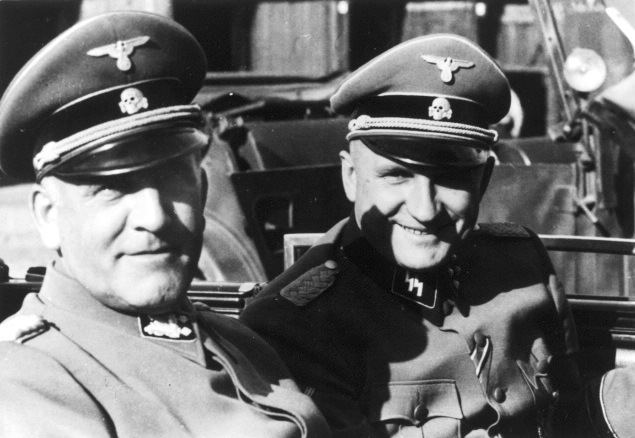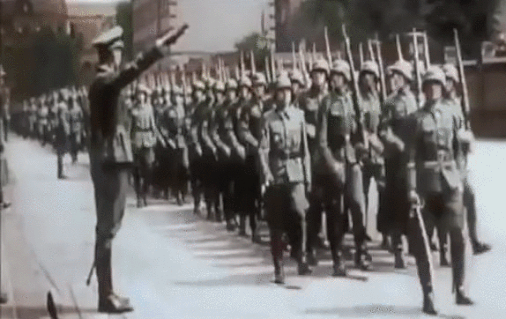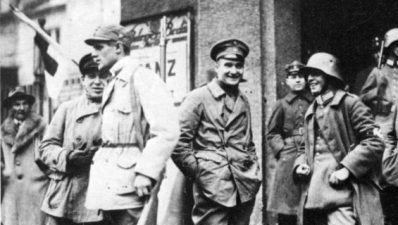Unit SS-Totenkopfverbande | Name Richard Glucks | |
 | ||
Rank Gruppenfuhrer, SS (Major General) Service number NSDAP #214,805SS #58,706 | ||
Richard Glücks (22 April 1889 – 10 May 1945) was a high-ranking Nazi official in the SS. From November 1939 until the end of World War II, he was Concentration Camps Inspector (CCI), which became Amt D: Konzentrationslagerwesen under the WVHA in Nazi Germany. As a direct subordinate of Heinrich Himmler, he was responsible for the forced labour of the camp inmates, and was also the supervisor for the medical practices in the camps, ranging from human experimentation to the implementation of the "Final Solution", in particular the mass murder of inmates with Zyklon-B gas. After Germany capitulated, Glücks committed suicide by swallowing a potassium cyanide capsule.
Contents

Early life

Glücks was born 1889 in Odenkirchen (now part of Mönchengladbach) in the Rhineland. Having completed gymnasium in Düsseldorf, he worked in his father's business, a fire insurance agency. In 1909, Glücks joined the army for one year as a volunteer, serving in the artillery. In 1913, he was in England, and later moved to Argentina as a trader. When World War I broke out, Glücks returned to Germany under a false identity on a Norwegian ship in January 1915 and joined the army again. During the war, he eventually became the commander of an artillery unit and was awarded the Iron Cross I and II. Glücks fought at the Battle of Verdun and the Battle of the Somme. After the war, he became a liaison officer between the German forces and the Military Inter-Allied Commission of Control, the allied body for controlling the restrictions placed upon Germany in the Treaty of Versailles regarding re-armament and strength of their armed forces. Until 1924, he stayed in that position, before joining the staff of the 6th Prussian Division. He also served in the Freikorps.
Rise under the Nazi regime

Glücks joined the NSDAP in 1930 and two years later, the SS. From 6 September 1933 to 20 June 1935 he was a member of the staff of the SS-Group "West" and rose to the rank of an SS-Sturmbannführer. While lacking in charisma, historian Nikolaus Wachsmann claims Glücks possessed an "abundance of ideological commitment." Subsequently, he became the commander of the 77th SS-Standarte of the Allgemeine SS with the rank of an SS-Obersturmbannführer. On 1 April 1936 he became the chief of staff to Theodor Eicke, who was then Concentration Camps Inspector and head of the SS-Wachverbände; first with the rank of a Standartenführer and later rising to Oberführer.
Concentration Camps Inspector

When Eicke became field commander of the SS Division Totenkopf during the summer of 1939, Glücks was promoted by Himmler on 15 November 1939 as Eicke's successor to the post of Concentration Camps Inspector. As the Concentration Camps Inspector, Glücks was directly subordinate to Himmler—as Eicke had been—but, in contrast with the warm relation between Himmler and the older Eicke, Glücks only rarely met with Himmler, who promoted him not for his leadership competencies but for his ability to "provide the administrative continuity" with Eicke's policies. Glücks made few changes, leaving the organizational structure intact as Eicke had set it up. Because Glücks never served inside a concentration camp, some senior camp members were suspicious and considered him nothing more than a desk-side bureaucrat. In terms of his leadership style, he preferred men of action and allowed them some autonomy in operating their respective camps.

Glücks's responsibilities at first mainly covered the use of concentration camp inmates for forced labour. In this phase, he urged camp commandants to lower the death rate in the camps, as it went counter to the economic objectives his department was to fulfill. Other orders of his were to ask for the inmates to be made to work continuously. At the same time, it was Glücks who recommended on 21 February 1940, Auschwitz, a former Austrian cavalry barracks, as a suitable site for a new concentration camp to Himmler and Heydrich. Glücks accompanied Himmler and several chief directors of I.G. Farben on 1 March 1941 for a visit to Auschwitz, where it was decided that the camp would be expanded to accommodate up to 30,000 prisoners, an additional camp would be established at nearby Birkenau capable of housing 100,000 POWs, and that a factory would be constructed in proximity with the camp prisoners placed at I.G. Farben's disposal.

On 20 April 1941 Glücks was promoted to the rank of an SS-Brigadeführer and in November 1943, Glücks was made SS-Gruppenführer and a Generalleutnant of the Waffen-SS. From 1942 on, Glücks was increasingly involved in the implementation of the "Final Solution", along with Pohl. To oversee the coordination of camp related activities, which varied from the medical concerns of personnel and prisoners, the status of construction projects, and the progress of extermination operations, Glücks, along with other senior SS camp managers, attended weekly meetings conducted by Pohl. Glücks never attempted to outshine his superior and was quite aware of his subordination to Pohl.
Wannsee conference
Just a few days after the Wannsee Conference in January 1942, Himmler ordered Glücks to prepare the camps for the immediate arrival of 100,000 Jewish men and 50,000 women being evacuated from the Reich as labourers in lieu of the diminishing availability of Russian prisoners. In July 1942, he participated in a planning meeting with Himmler on the topic of medical experiments on camp inmates. From several visits to the Auschwitz concentration camps, Glücks was well aware of the mass murders and other atrocities committed there. Correspondingly, Auschwitz Kommandant Rudolf Höss routinely informed Glücks on the status of the extermination activities. During one of his inspection-tour visits to Auschwitz in 1943, Glücks complained about the unfavorable location of the crematoria since all types of people would be able to "gaze" at the structures. Responding to this observation, Höss ordered a row of trees planted between Crematorias I and II. When visits from high officials from the Reich or the Nazi Party took place, the administration was instructed by Glücks to avoid showing the crematorias to them; if questions arose about smoke coming from the chimneys, the installation personnel were to tell the visitors that corpses were being burned as a result of epidemics.
In 1942, the CCI became "Amt D" of the Wirtschafts- und Verwaltungshauptamt (SS Economic and Administrative Department; WVHA) under SS-Obergruppenführer Oswald Pohl. Glücks continued to manage the camp administration until the end of the war. Therefore, the entire concentration camp system was placed under the authority of the WVHA with the Inspector of Concentration Camps now a subordinate to the Chief of the WVHA.
According to historian Leni Yahil, Glücks was "the RSHA man responsible for the entire network of concentration camps" and his authority extended to the largest and most infamous of them all, Auschwitz. From what historian Martin Broszat relates, nearly all the important matters concerning the concentration camps were "decided directly between the Inspector of Concentration Camps and the Reichsführer-SS." In January 1945, Glücks was decorated for his contributions to the Reich in managing the fifteen largest camps and the five-hundred satellite camps which employed upwards of 40,000 members of the SS. Glücks' role in the Holocaust "cannot be over-emphasized" as he, together with Pohl, oversaw the entire Nazi camp system and the persecution network it represented.
Death
When the WVHA offices in Berlin were destroyed by Allied bombing on 16 April 1945, the WVHA was moved to Born on Darß in Pomerania on the Baltic sea. Owing to the advances of the Red Army forces, Glücks and his wife fled to Flensburg.
After the capitulation of Germany, he is believed to have committed suicide on 10 May 1945 by swallowing a capsule of potassium cyanide at the Mürwik naval base in Flensburg-Mürwik, although the lack of official records or photos gave rise to speculation about his ultimate fate. There is suspicion that Jewish avengers may have killed Glücks for his role in the Final Solution.
